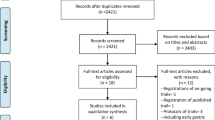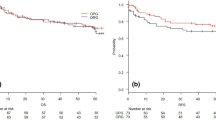Abstract
Background
Omentectomy is considered an essential part of curative gastrectomy for locally advanced gastric cancer (GC), albeit without solid evidence. We conducted a randomized phase II trial (the TOP-G trial) comparing omentectomy and omentum preservation for gastric cancer. This report describes the short-term findings regarding the trial’s secondary endpoints.
Methods
The trial protocol was submitted to the University Hospital Medical Information Network Clinical Trials Registry (http://www.umin.ac.jp/ctr/: UMIN000005421). The key eligibility criteria were histologically confirmed cT2–4a and N0–2 gastric adenocarcinoma. Short-term surgical outcomes, including morbidity and mortality, were compared between the omentectomy group (group A, control arm) and the omentum-preserving surgery group (group B, test arm). All procedures were performed via an open approach. Based on a non-inferiority margin of 7%, statistical power of 0.7, and type I error of 0.2, the sample size was set to 250 patients.
Results
A total of 251 patients were eligible and randomized (group A: 125 patients, group B: 126 patients) between April 2011 and October 2018. After excluding patients who had peritoneal metastasis or laparotomy history, safety outcomes were analyzed for 247 patients. Group A had a significantly longer median operation time (225 min vs. 204 min, p = 0.022) and tended to have greater median blood loss (260 mL vs. 210 mL p = 0.073). The incidences of morbidity were similar and < 10% in both groups (8% vs. 9%, p = 1.000). There was no mortality in either group.
Conclusions
Operative risk was generally similar between omentectomy and omentum-preserving surgery for locally advanced gastric cancer.

Similar content being viewed by others
References
Ferlay J, Soerjomataram I, Dikshit R et al (2015) Cancer incidence and mortality worldwide: sources, methods and major patterns in GLOBOCAN 2012. Int J Cancer 136:E359–E586
Oosterling SJ, van der Bij GJ, Bogels M et al (2006) Insufficient ability of omental milky spots to prevent peritoneal tumor outgrowth supports omentectomy in minimal residual disease. Cancer Immunol Immunother 55:1043–1051
Hagiwara A, Takahashi T, Sawai K et al (1993) Milky spots as the implantation site for malignant cells in peritoneal dissemination in mice. Cancer Res 53:687–692
Kodera Y, Nakanishi H, Ito S et al (2002) Quantitative detection of disseminated cancer cells in the greater omentum of gastric carcinoma patients with real-time RT-PCR: a comparison with peritoneal lavage cytology. Gastric Cancer 5:69–76
Hagiwara A, Sawai K, Sakakura C et al (1998) Complete omentectomy and extensive lymphadenectomy with gastrectomy improves the survival of gastric cancer patients with metastases in the adjacent peritoneum. Hepatogastroenterology 45:1922–1929
Etoh T, Sasako M, Ishikawa K et al (2006) Extranodal metastasis is an indicator of poor prognosis in patients with gastric carcinoma. Br J Surg 93:369–373
Groves EW (1910) On the radical operation for cancer of the pylorus: with especial reference to the advantages of the two-stage operation and to the question of the removal of the associated lymphatics. Br Med J 1:366–370
Kurokawa Y, Doki Y, Mizusawa J et al (2018) Bursectomy versus omentectomy alone for resectable gastric cancer (JCOG1001): a phase 3, open-label, randomised controlled trial. Lancet Gastroenterol Hepatol 3:460–468
Ha TK, An JY, Youn HG et al (2008) Omentum-preserving gastrectomy for early gastric cancer. World J Surg 32:1703–1708
Hasegawa S, Kunisaki C, Ono H et al (2013) Omentum-preserving gastrectomy for advanced gastric cancer: a propensity-matched retrospective cohort study. Gastric Cancer 16:383–388
Kim DJ, Lee JH, Kim W (2014) A comparison of total versus partial omentectomy for advanced gastric cancer in laparoscopic gastrectomy. World J Surg Oncol 12:64
Ri M, Nunobe S, Honda M et al (2020) Gastrectomy with or without omentectomy for cT3-4 gastric cancer: a multicentre cohort study. Br J Surg. https://doi.org/10.1002/bjs.11702
Hasegawa S, Yamamoto Y, Taguri M et al (2013) A randomized phase II trial of omentum-preserving gastrectomy for advanced gastric cancer. Jpn J Clin Oncol 43:214–216
Japanese Gastric Cancer Association (2017) Japanese gastric cancer treatment guidelines 2014 (ver. 4). Gastric Cancer 20:1–19
Japanese Gastric Cancer Association (2011) Japanese classification of gastric carcinoma: 3rd English edition. Gastric Cancer 14: 101–112
Sano T, Sasako M, Mizusawa J et al (2017) Randomized controlled trial to evaluate splenectomy in total gastrectomy for proximal gastric carcinoma. Ann Surg 265:277–283
Dindo D, Demartines N, Clavien PA (2004) Classification of surgical complications: a new proposal with evaluation in a cohort of 6336 patients and results of a survey. Ann Surg 240:205–213
Inoue K, Nakane Y, Michiura T et al (2012) Ultrasonic scalpel for gastric cancer surgery: a prospective randomized study. J Gastrointest Surg 16:1840–1846
Cheng H, Hsiao CW, Clymer JW et al (2015) Gastrectomy and D2 lymphadenectomy for gastric cancer: a meta-analysis comparing the harmonic scalpel to conventional techniques. Int J Surg Oncol 2015:397260
Acknowledgements
We thank all of the patients, their families, the investigators, and medical staff members who participated in this study.
Author information
Authors and Affiliations
Contributions
SH, TY, and TY conceived of and designed the trial. HM and TY were the principal investigators. MT, HM, TY, and TY were responsible for the data analysis. All authors contributed to the data acquisition and interpretation. HM, TY, and TY draft the article. All authors contributed to the writing of the final manuscript and approved the final version. All authors agree to be accountable for all aspects of the work and to ensure that questions related to the accuracy or integrity of any part of the work are appropriately investigated and resolved.
Corresponding authors
Ethics declarations
Conflict of interest
Dr. Yamada reports personal fees from ONO Pharmaceutical and personal fees from Bristol-Myers Squibb, outside the submitted work. Dr. Yamanaka reports grants and personal fees from Takeda, grants and personal fees from Chugai, grants and personal fees from Boehringer Ingelheim, grants and personal fees from Taiho, grants and personal fees from Daiichi-Sankyo, grants from Ono, grants and personal fees from Bayer, grants from Merck Serono, grants from Astellas, grants from Eli Lilly, personal fees from Pfizer, personal fees from Sysmex, personal fees from Huya Biosciences, and personal fees from Gilead Sciences, outside the submitted work. Dr. Rino reports personal fees from Taiho pharmaceutical, personal fees from Abbott, personal fees from Asahi Kasei, personal fees from Daiichi-Sankyo, personal fees from Tsumura & Co, personal fees from Covidien, personal fees from Zeria pharmaceutical, personal fees from EA Pharma, personal fees from Johnson and Johnson, personal fees from Otsuka, other from Lilly, other from Bristol-Myers Squibb, other from Daiichi-Sankyo, other from Johnson and Johnson, other from Otsuka, and other from Taiho pharmaceutical, outside the submitted work. Dr. Oshima reports grants from Taiho pharmaceutical Co., Ltd, grants from Chugai pharmaceutical Co., Ltd, grants from Ono pharmaceutical Co., Ltd, grants from Daiichi-Sankyo pharmaceutical, grants from Nippon Kayaku Co., Ltd, grants from Eli Lilly Japan K. K., personal fees from Nippon Kayaku Co., Ltd, personal fees from Ono pharmaceutical Co., Ltd, personal fees from Bristol-Myers Squibb K. K., personal fees from Taiho pharmaceutical Co., Ltd, personal fees from Chugai pharmaceutical Co., Ltd, and personal fees from Eli Lilly Japan K. K., outside the submitted work. Dr. Yoshikawa reports personal fees from MSD, personal fees from BMS, personal fees from ONO, personal fees from Taiho, personal fees from Chugai, personal fees from Nihon Kayaku, grants and personal fees from Lilly, personal fees from Pfizer, personal fees from TERUMO, personal fees from Johnson and Johnson, and personal fees from Covidien, outside the submitted work; All the remaining authors have no conflicts of interest to declare.
Ethical approval
This trial was registered with the University Hospital Medical Information Network Clinical Trials Registry (http://www.umin.ac.jp/ctr/: UMIN000005421) and was approved by the ethical review boards of the participating institutions. All patients provided informed consent before enrollment.
Additional information
Publisher's Note
Springer Nature remains neutral with regard to jurisdictional claims in published maps and institutional affiliations.
Rights and permissions
About this article
Cite this article
Murakami, H., Yamada, T., Taguri, M. et al. Short-Term Outcomes from a Randomized Screening Phase II Non-inferiority Trial Comparing Omentectomy and Omentum Preservation for Locally Advanced Gastric Cancer: the TOP-G Trial. World J Surg 45, 1803–1811 (2021). https://doi.org/10.1007/s00268-021-05988-7
Accepted:
Published:
Issue Date:
DOI: https://doi.org/10.1007/s00268-021-05988-7




